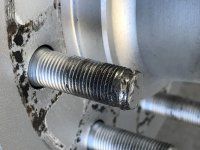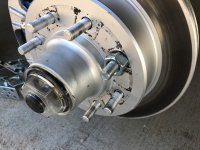David-and-Cheryl
Well-known member
Our trailer tires aged out, so we decided to upgrade them to Load Range H G114s, which also necessitated new wheels.
When I went to change the wheels, I discovered that one of the wheel studs is badly damaged. It looks like it was over-torqued when I had my new Titan disc brakes installed just a couple weeks ago. I managed to remove the damaged lug nut with a lot of effort, but there is no way a new nut will go on to the stud.

Ron at Performance Trailer Braking (TitanGuy) is overnighting me a new stud, which will arrive in the next couple hours. Coach-Net will try to find me a mobile tech who can replace the damaged stud here in the RV park, but I'm not sure they'll be able to locate someone with the right tools, and I'm not even certain it can be done in the field at all. I've seen instructions on the web to use a tie rod end removal tool or a ball joint separator tool to press the stud out of the hub, but because the Titan disc rotor is integrated with the hub and can't be removed (see photo), I don't think either of those tools will be able to reach around the rotor.

So, my questions:
1. Can the stud be hammered out with the hub assembly still mounted on the trailer? I've read that this is a bad idea because it risks damaging the hub and the bearings, but apparently it's a common practice. I suspect a mobile tech is going to take this approach, and I want to be ready to say no and tell him why if so.
2. Is there any other way to remove the damaged stud in the field?
3. If I run out of other options, can I safely drive the trailer to a shop (probably 14 miles or so) with only 7 of the 8 lug nuts fastened on that one wheel? We are right at our GVWR on the trailer, although the new brakes, wheels and tires are all rated for more weight than that. I will of course use a torque wrench to properly torque the nuts to specs.
When I went to change the wheels, I discovered that one of the wheel studs is badly damaged. It looks like it was over-torqued when I had my new Titan disc brakes installed just a couple weeks ago. I managed to remove the damaged lug nut with a lot of effort, but there is no way a new nut will go on to the stud.

Ron at Performance Trailer Braking (TitanGuy) is overnighting me a new stud, which will arrive in the next couple hours. Coach-Net will try to find me a mobile tech who can replace the damaged stud here in the RV park, but I'm not sure they'll be able to locate someone with the right tools, and I'm not even certain it can be done in the field at all. I've seen instructions on the web to use a tie rod end removal tool or a ball joint separator tool to press the stud out of the hub, but because the Titan disc rotor is integrated with the hub and can't be removed (see photo), I don't think either of those tools will be able to reach around the rotor.

So, my questions:
1. Can the stud be hammered out with the hub assembly still mounted on the trailer? I've read that this is a bad idea because it risks damaging the hub and the bearings, but apparently it's a common practice. I suspect a mobile tech is going to take this approach, and I want to be ready to say no and tell him why if so.
2. Is there any other way to remove the damaged stud in the field?
3. If I run out of other options, can I safely drive the trailer to a shop (probably 14 miles or so) with only 7 of the 8 lug nuts fastened on that one wheel? We are right at our GVWR on the trailer, although the new brakes, wheels and tires are all rated for more weight than that. I will of course use a torque wrench to properly torque the nuts to specs.





